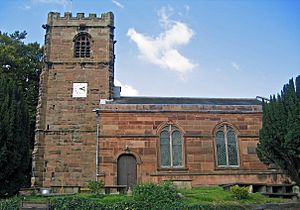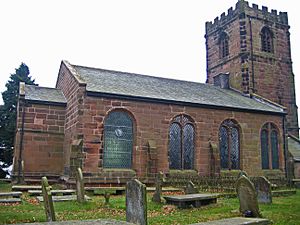St Peter's Church, Little Budworth facts for kids
Quick facts for kids St Peter's Church, Little Budworth |
|
|---|---|

St Peter's Church, Little Budworth, from the south
|
|
| Lua error in Module:Location_map at line 420: attempt to index field 'wikibase' (a nil value). | |
| OS grid reference | SJ 598,655 |
| Location | Little Budworth, Cheshire |
| Country | England |
| Denomination | Anglican |
| Website | St Peter, Little Budworth |
| History | |
| Status | Parish church |
| Dedication | St Peter |
| Architecture | |
| Functional status | Active |
| Heritage designation | Grade II* |
| Designated | 3 January 1967 |
| Architect(s) | John Douglas (restoration) |
| Architectural type | Church |
| Style | Perpendicular, Neoclassical |
| Completed | 1871 |
| Specifications | |
| Materials | Red sandstone Slate roof |
| Administration | |
| Parish | Little Budworth, St Peter |
| Deanery | Middlewich |
| Archdeaconry | Chester |
| Diocese | Chester |
| Province | York |
St Peter's Church is a beautiful old church located in the village of Little Budworth, Cheshire, England. It's a very important building, listed as a Grade II* historic site. This means it's a special building with a lot of history and unique features. The church is still active today, serving as a local Anglican parish church. Its tall tower stands on the highest point in the village, making it a noticeable landmark for miles around.
There's a bit of a mystery about the church's exact name. Some old records suggest it was once called St Mary and All Saints. However, a gift given in 1526 mentioned "St. Peter of Budworth." Today, most people know it as St Peter's Church. Some even think its full original name might have been "St Mary, St Peter and All Saints."
Contents
History of St Peter's Church
Early Beginnings and Rebuilding
Records show that a church has stood on this spot since at least 1190. The tall stone tower you see today was built much later, between 1490 and 1526. The main part of the church was rebuilt in stone around 1800. This happened thanks to a generous gift from Ralph Kirkham, a rich merchant from Manchester. The new design included a nave (the main part where people sit) and a sanctuary (the area around the altar).
Changes Over the Years
The Egerton family, who lived nearby at Oulton Hall, were big supporters of the church. Their family burial vault was inside the church, but it was sealed up in 1870. From 1870 to 1871, the inside of the church got a big makeover. An architect from Chester named John Douglas led this work. He removed old pews, a gallery, and the ceiling to update the church's look. Later, in 1936, the wooden roof became unsafe. It was replaced with a stronger steel roof to keep the building safe.
Architecture and Design
Outside the Church
St Peter's Church is built from red sandstone blocks, and its roof is made of slate. The church has a west tower and a main section that includes the nave and chancel. The tower has strong diagonal supports called buttresses. It's divided into three levels by stone bands called string courses.
On the lowest level of the tower, there's an arched main door. Above it, you'll see a window with three sections, and an empty niche (a small alcove) even higher up. On the south side of the tower, there's a clock face from 1785. The very top of the tower has openings for bells, and a decorative, castle-like top called an embattled parapet. The sides of the church have arched windows that let in light.
Inside the Church
The ceilings inside the nave and chancel are curved and plastered, like a barrel vault. The pulpit, where sermons are given, is from the 1800s. The font, used for baptisms, is even older, from the 17th century. It's painted and has a unique fluted (grooved) bowl with a decorative cover. This is one of the few painted fonts left in the county!
The church also has a special family pew from the 19th century. You can find memorials to the Egerton family, including a brass plaque about an event in the Crimean War. Philip R. Egerton once gave the church a painting by the famous artist Caravaggio, or someone from his art school. This painting shows The Deposition from the Cross.
A few small pieces of very old stained glass from before the Reformation are still in the church. There's also a beautiful stained glass war memorial for Egerton family members who died in the First World War. This was made by Heaton, Butler and Bayne.
Musical Instruments and Bells
The church has a special organ made by William Hill & Sons of London around 1860. It's quite unique because it still uses its original hand-pumped bellows! In the tower arch, there's a modern etched window from 2002.
The church also has a set of five bells. Three of these bells are very old, dating back to 1714, and were made by Rudhall of Gloucester. The other two bells were added later, one in 1884 and another in 1893. The church's parish registers, which record important events like births and deaths, go all the way back to 1561.
Churchyard and War Graves
The churchyard around St Peter's is divided into "Old Ground" and "New Ground." This is where people from the village have been buried for centuries. The churchyard also contains the war graves of four soldiers who died during World War I. Three of these graves are in the "New Ground" section.
More to Explore
- Grade II* listed buildings in Cheshire West and Chester
- Listed buildings in Little Budworth
- List of church restorations, amendments and furniture by John Douglas


